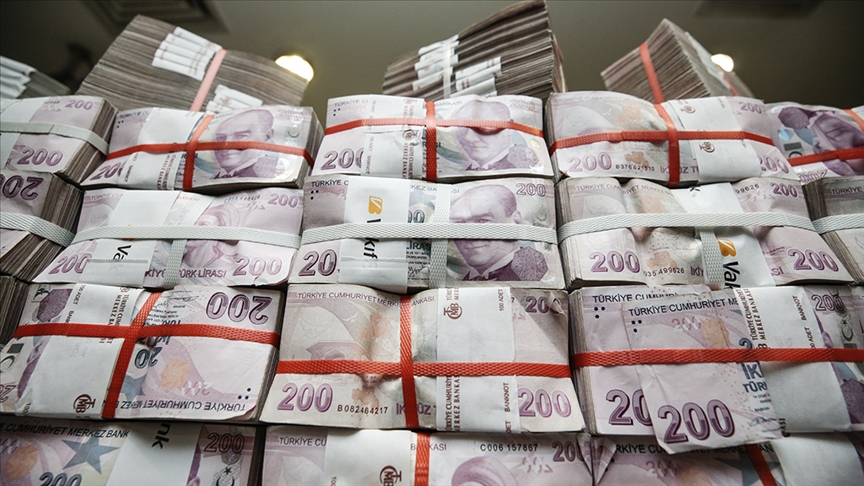

Did you know that Türkiye dropped six zeros from its currency 20 years ago? Now these zeros are returning amid high inflation and low cost of living. Will Türkiye print larger banknotes?
Türkiye may print 500 and 1000 Turkish Lira banknotes amid increasing inflation and currency crisis.
This time last year, former Minister of Treasury and Finance, Nurettin Nebati was saying “there is no need for such measure,” when asked if there will be any banknotes with larger denomination.
His ministry was obeying the instructions of President Recep Tayyip Erdoğan to keep the policy interest rates low, selling foreign currencies from the state coffers, waiting for the inflation to fall and the money in circulation to decrease.
This did not happen. Inflation has increased, the cost of living has increased, the pre-election spending budget got bigger and bigger, and brand new, inky-smelling banknotes printed by the Central Bank of Republic of Turkey (CBRT) have been put into circulation.
Pro-government Civil Servants’ Union (Memur-Sen) bargaining with the Ministry of Labour, just to keeping up appearances, calculating that the lowest civil servant salary should be 31 thousand liras. It was raised to 11,402 Liras at the beginning of the year. What can one buy with that money now?
One of our readers wrote to us saying that he bought two sandwiches and two beverages for 360 liras the other day and he gave “two 200 banknotes”, two of the largest notes.
When you buy a kilo of minced meat, you also give two 200s.
Banknotes lose value as they swell
Currently, there are six different denominations of banknotes in circulation in Türkiye, for 5, 10, 20, 50, 100 and 200. The largest one is 200.
In 2009, it was issued under the signature of Durmuş Yılmaz, then Governor of the Central Bank.
Mehmet Şimşek was the Minister of State in charge of the Economy, including the Treasury.
After the ruling Justice and Development Party (AKP) came to power in 2002, inflation was brought under control under the administration of Ali Babacan, who continued the economic programme he had taken over from Kemal Derviş in his own way.
In his term six zeros were removed from the currency in 2005, and the New Turkish Lira was introduced, replacing the previous lira at a rate of a 1 to a million. Yes the “Old” Turkish Lira had hit the millions in banknote denominations before 2005.
How was it before that?
The first 500 lira banknotes started to be printed in 1971, when I was a child and inflation hit. I was young, but I remember, when 1000 lira notes were issued, well-to-do people said, “it is a good thing,” “We won’t be walking around with a wad in our pockets.”
Then 5 thousand, 10 thousand, 100 thousand, 1 million, 20 million banknotes were issued.
Our pockets were filled with wads of paper that had no value; you could enter the public toilets for 1 million liras.
The zeros which were removed from the lira are actually coming back with unstoppable price increases and the decrease in purchasing power.
Interest rate dispute continues at home
Erdoğan, who dismissed Mehmet Şimşek in 2018 and replaced him with hisson-in-law Berat Albayrak because he disagreed with Erdoğan’s thesis that “interest is the cause of inflation,” had to persuade him to return in 2023.
He did not give Şimsek the management of the entire economy but gave him de facto influence over the Ministry of Treasury and Finance and the Central Bank.
After Simsek, Hafize Gaye Erkan became the Governor of the Central Bank. He appointed Cevdet Yılmaz, the AKP’s economist he trusted the most, as Vice President.
Erkan announced an increase in the policy rate from 8.5 to 15, after almost two years of low-rate policy. The increase followed by the change of Monetary Policy Committee (MPC) members after the second meeting where the policy rate was increased from 15 to 17.5.
Now the new MPC is signalling of a gradual exit from the contentious Currency Protected Deposits (FXPD) scheme which is a signal that the current measures are not sufficient and that new steps are necessary.
At the same time, it is understood that the interest rate-inflation struggle continues. The latest MPC decision actually means “we cannot increase the policy rate too much for obvious reasons, let the banks increase it”.
After the cabinet meeting on August 21, Erdoğan was mentioning about “the codes of the mandatory imposition that looks at the Turkish economy only from the interest and exchange rate window”.
Signature on the 500s banknotes
Ankara’s preference to sit on a fence in foreign policy in recent weeks is clearly related to the difficulties in finding foreign funding.
On his return from Hungary before the cabinet meeting, Erdoğan said, “It is not something that will happen if our civil servants get raises and our pensioners get nothing,” like an opposition leader as if he was not in the government. However, the good news of “interim raise for pensioners”, which was headlined with these words by the pro-government media, did not come out of the cabinet meeting.
After the meeting, Erdoğan again asked for a little more patience from the citizens with the promise that inflation would drop to single digits (Erkan’s forecast for the end of 2026).
With the 31 March 2024 elections on the horizon, it is likely that salary increases will come, and money will be printed regardless of whether it is worth anything or not.
A return to the era of 500 and 1000 banknotes, which are considered to be a sign of high inflation, is also likely: perhaps even before the local elections.
If 500 banknotes are issued, they will probably bear the signature of CBRT Governor Erkan. I say probably, because the possibility of Erdoğan to return to his “yes sir” team saying “Look, we increased interest rates, but inflation is not falling” is still on the horison.
Maybe 500 banknotes will also be celebrated as a national economic holiday.
Resurgence of inflation in Türkiye: Turn to rationality or a red light


